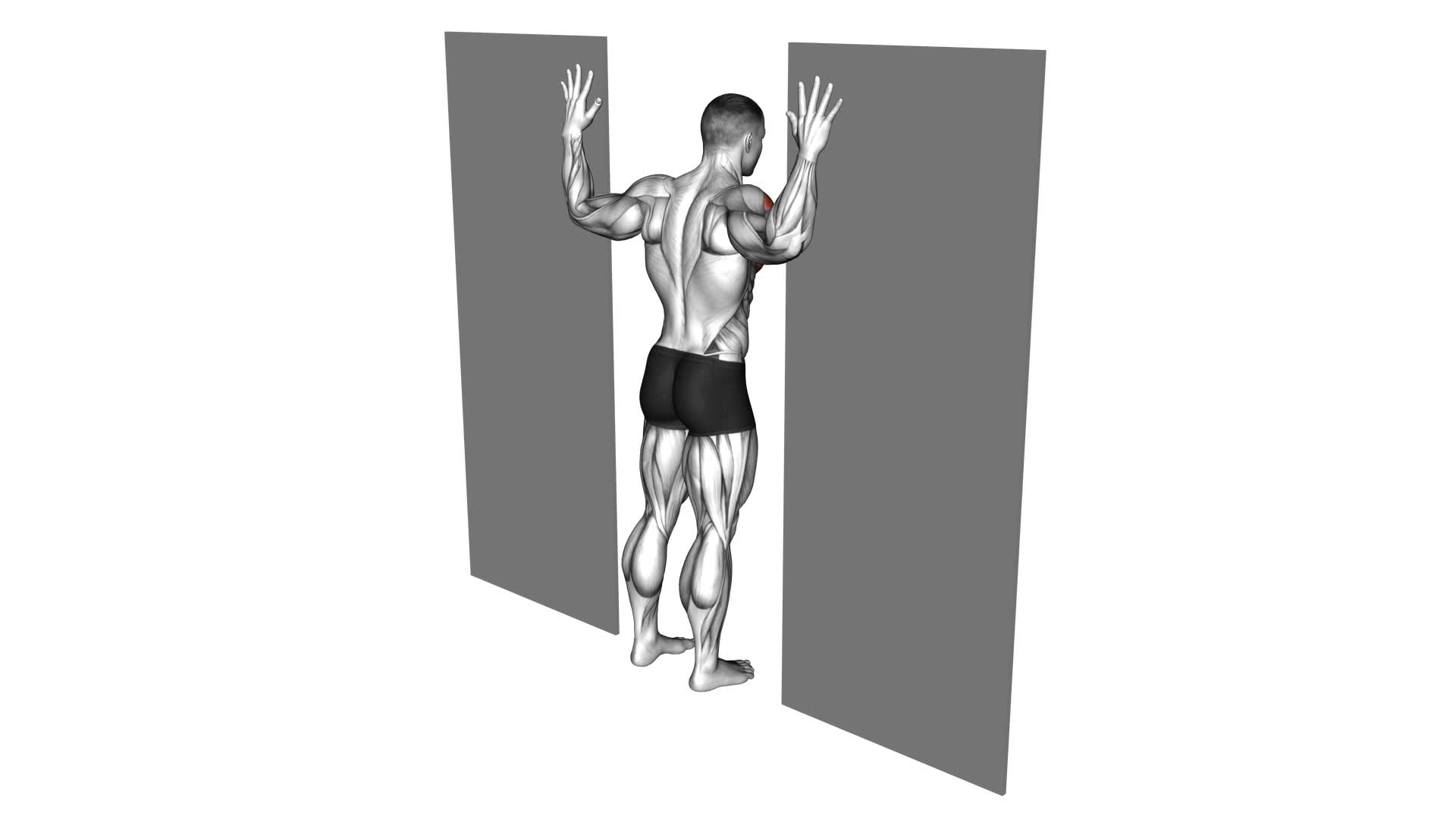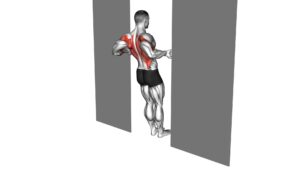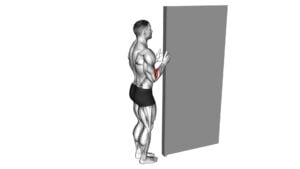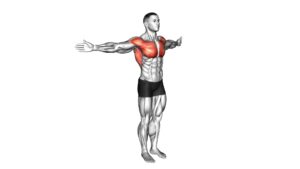Doorway Chest Stretch (male) – Video Exercise Guide & Tips

Are you looking for a quick and effective way to stretch your chest muscles? Look no further! In this video exercise guide, we'll show you how to do the doorway chest stretch.
Watch This Exercise Video
This stretch is perfect for men who want to improve their flexibility and prevent muscle tightness. Follow along as we demonstrate the proper technique, common mistakes to avoid, and tips for increasing intensity.
Get ready to feel the burn and unlock those tight muscles!
Key Takeaways
- The doorway chest stretch improves flexibility and prevents muscle tightness.
- It enhances overall flexibility and mobility.
- The stretch targets the chest and shoulder muscles.
- It improves posture, reduces the risk of rounded shoulders, alleviates upper back pain, and improves breathing.
Benefits of the Doorway Chest Stretch
To maximize the benefits of the Doorway Chest Stretch, position yourself between the door frame and actively push your chest forward and through the opening. This stretch is an essential part of any stretching routine, as it helps improve overall flexibility and mobility. Stretching is crucial for maintaining a healthy range of motion in your joints and muscles, and incorporating the doorway chest stretch into your daily routine can greatly contribute to achieving this.
The doorway chest stretch specifically targets the muscles in your chest and shoulders, helping to relieve tension and tightness in these areas. By opening up your chest and stretching the muscles, you can improve your posture and reduce the risk of developing rounded shoulders. Additionally, this stretch can also help alleviate upper back pain and improve breathing by expanding the chest cavity.
To incorporate the doorway chest stretch into your daily stretching routine, find a doorway with enough space to stretch your arms out fully. Stand with one foot in front of the other, and place your hands on either side of the door frame. Lean forward, pushing your chest through the opening, while keeping your back straight. Hold this stretch for 20-30 seconds, and then release.
Proper Technique for the Doorway Chest Stretch
Now, let's explore the proper technique for performing the doorway chest stretch to ensure maximum effectiveness and safety.
To begin, stand facing a doorway with your feet shoulder-width apart. Extend your arms out to the sides and bend your elbows to a 90-degree angle. Place your forearms against the doorframe, with your palms facing forward.
Next, take a step forward with one foot, allowing your body to lean slightly forward. This will create a stretch in your chest muscles. Hold this position for 20 to 30 seconds, focusing on deep breathing and relaxing into the stretch.
If you find the stretch too intense, you can modify it by adjusting your arm position. Instead of bending your elbows to a 90-degree angle, try placing your forearms higher or lower on the doorframe. This will allow you to control the intensity of the stretch and find a position that feels comfortable for you.
The best time to do the doorway chest stretch is after a workout or any activity that involves the chest muscles, such as weightlifting or push-ups. Stretching the chest muscles in this way can help improve flexibility and prevent tightness.
Now that you know the proper technique for the doorway chest stretch, let's move on to the next section and discuss common mistakes to avoid.
Common Mistakes to Avoid
To avoid common mistakes while performing the doorway chest stretch, make sure to maintain proper form and avoid these errors.
One common mistake is rounding your shoulders forward instead of keeping them back and down. This can put unnecessary strain on your neck and upper back.
Another mistake to avoid is arching your lower back excessively. Instead, engage your core muscles and keep your spine in a neutral position.
It's also important to avoid pushing too hard or using excessive force during the stretch. Remember that the goal is to gently stretch the chest muscles, not to push them to their limits.
Additionally, be cautious not to let your elbows flare out to the sides. Keep them in line with your shoulders to ensure proper alignment.
Lastly, make sure to avoid holding your breath while performing the stretch. Remember to breathe deeply and continuously throughout the movement.
Tips for Increasing Intensity
To increase the intensity of the doorway chest stretch, consider using a resistance band or adding weights to challenge your muscles further. Here are some tips to help you increase the intensity of your doorway chest stretch:
- Advanced modifications:
- Try using a resistance band: Attach a resistance band to the doorknob and hold onto the handles while performing the stretch. This will provide additional resistance, making the exercise more challenging.
- Add weights: Hold a pair of dumbbells or a weighted plate in your hands while performing the stretch. This will increase the load on your chest muscles, making them work harder.
- Progressive overload techniques:
- Increase resistance gradually: Start with a lighter resistance band or smaller weights and gradually increase the resistance or weight as your muscles get stronger. This will help you progressively overload your muscles and promote further growth and strength development.
- Increase the duration of the stretch: Hold the stretch for a longer period of time, gradually increasing the duration as your flexibility improves. This will help you further stretch and strengthen your chest muscles.
By incorporating these advanced modifications and progressive overload techniques into your doorway chest stretch routine, you can effectively increase the intensity and challenge your muscles in new ways.
Now, let's explore some variations of the doorway chest stretch.
Variations of the Doorway Chest Stretch
Try incorporating different hand positions to vary the doorway chest stretch and target different areas of your chest muscles. There are several advanced variations of the doorway chest stretch that can provide targeted stretches for specific muscle groups.
One variation is the high hand position, where you place your hands above shoulder level on the doorframe. This targets the upper chest muscles more intensely.
Another variation is the low hand position, where you place your hands below shoulder level on the doorframe. This targets the lower chest muscles and can help improve overall chest development.
Additionally, you can try the staggered hand position, where you place one hand higher and the other hand lower on the doorframe. This provides a stretch that targets both the upper and lower chest muscles simultaneously.
It's important to listen to your body and adjust the hand positions based on your comfort level and flexibility. By incorporating these different hand positions into your doorway chest stretch routine, you can effectively target and stretch various areas of your chest muscles for optimal muscle development and flexibility.
Frequently Asked Questions
How Often Should I Perform the Doorway Chest Stretch?
To get the most out of the doorway chest stretch, it's important to know how often to do it. The frequency of the chest stretch depends on your fitness goals and current level of flexibility.
Generally, it's recommended to perform the doorway chest stretch 2-3 times a week. This allows your muscles to recover and adapt to the stretch, leading to increased flexibility and better posture.
Don't overdo it, though, as too much stretching can cause injury.
Can the Doorway Chest Stretch Help With Improving Posture?
Improving your posture is possible with the doorway chest stretch. This exercise focuses on stretching your chest muscles and increasing flexibility in your shoulders. By regularly performing this stretch, you can improve your shoulder mobility and reduce any tightness in your chest.
It helps open up your chest and counteract the effects of slouching or hunching over. Incorporating the doorway chest stretch into your routine can make a noticeable difference in your posture.
Is It Safe to Perform the Doorway Chest Stretch if I Have a Shoulder Injury?
If you have a shoulder injury, it's important to consider safe exercises for shoulder injury management.
The doorway chest stretch may not be the best option for you as it can put strain on the injured shoulder.
Instead, you can try alternative chest stretches that don't involve the shoulders as much. These include standing or seated chest stretches using a resistance band or doing a wall stretch.
Always consult with a healthcare professional for personalized advice.
Can the Doorway Chest Stretch Help With Alleviating Back Pain?
The Doorway Chest Stretch can be helpful in alleviating back pain. By stretching the chest muscles, it helps to improve posture, which can reduce strain on the back.
This stretch targets the pectoral muscles and the muscles of the shoulders, promoting flexibility and relieving tension.
Incorporating the Doorway Chest Stretch into your routine can have long-term benefits for posture improvement and back pain relief.
Give it a try and see the difference it can make.
What Are Some Other Exercises That Can Be Combined With the Doorway Chest Stretch for a Full Upper Body Workout?
To get a full upper body workout, you can combine the doorway chest stretch with push up variations and resistance band exercises.
Push up variations like diamond push ups and incline push ups target different muscles in your chest and arms.
Resistance band exercises like bicep curls and tricep extensions work your upper body muscles with added resistance.
Conclusion
In conclusion, the doorway chest stretch is a beneficial exercise for improving chest flexibility and posture. By following the proper technique, avoiding common mistakes, and incorporating tips for increasing intensity, you can maximize the benefits of this stretch.
Additionally, there are variations of the doorway chest stretch that can be explored to target different areas of the chest.
Incorporating this stretch into your regular exercise routine can help enhance your overall upper body strength and flexibility.

Author
Years ago, the spark of my life’s passion ignited in my mind the moment I stepped into the local gym for the first time. The inaugural bead of perspiration, the initial endeavor, the very first surge of endorphins, and a sense of pride that washed over me post-workout marked the beginning of my deep-seated interest in strength sports, fitness, and sports nutrition. This very curiosity blossomed rapidly into a profound fascination, propelling me to earn a Master’s degree in Physical Education from the Academy of Physical Education in Krakow, followed by a Sports Manager diploma from the Jagiellonian University. My journey of growth led me to gain more specialized qualifications, such as being a certified personal trainer with a focus on sports dietetics, a lifeguard, and an instructor for wellness and corrective gymnastics. Theoretical knowledge paired seamlessly with practical experience, reinforcing my belief that the transformation of individuals under my guidance was also a reflection of my personal growth. This belief holds true even today. Each day, I strive to push the boundaries and explore new realms. These realms gently elevate me to greater heights. The unique combination of passion for my field and the continuous quest for growth fuels my drive to break new ground.



